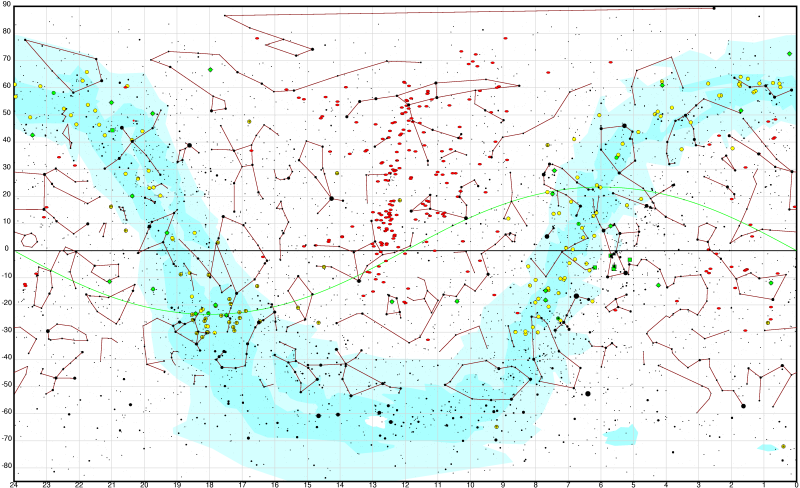Distribution of Herschel 400 objects

Red = Galaxies, Green = Nebulae, Yellow = Star Clusters
The Herschel 400 catalogue is a subset of William Herschel's original Catalogue of Nebulae and Clusters of Stars , selected by Brenda F. Guzman (Branchett), Lydel Guzman, Paul Jones, James Morris, Peggy Taylor and Sara Saey of the Ancient City Astronomy Club in St. Augustine, Florida, United States c. 1980. They decided to generate the list after reading a letter [1] published in Sky & Telescope by James Mullaney of Pittsburgh, Pennsylvania, United States. [2]
In this letter Mr. Mullaney suggested that William Herschel's original catalogue of 2,500 objects would be an excellent basis for deep sky object selection for amateur astronomers looking for a challenge after completing the Messier Catalogue.
The Herschel 400 is a subset of John Herschel's General Catalogue of Nebulae and Clusters published in 1864 of 5,000 objects, and hence also of the New General Catalogue .
The catalogue forms the basis of the Astronomical League's Herschel 400 club. In 1997, another subset of 400 Herschel objects was selected by the Rose City Astronomers of Portland, Oregon as the Herschel II list, which forms the basis of the Astronomical League's Herschel II Program.

The Herschel 400 contains 17 objects that are part of the Messier catalogue:
| Messier | NGC | Common name | Notes |
|---|---|---|---|
| M20 | NGC 6514 | Trifid Nebula | |
| M33 | NGC 598 | Triangulum Galaxy | |
| M47 | NGC 2422 | ||
| M48 | NGC 2548 | ||
| M51b | NGC 5195 | companion to the Whirlpool Galaxy | |
| M61 | NGC 4303 | Swelling Spiral Galaxy | |
| M76 | NGC 651 | Little Dumbbell Nebula, Barbell Nebula (northern portion) | |
| M82 | NGC 3034 | Cigar Galaxy | |
| M91 | NGC 4548 | ||
| M102? | NGC 5866 | Spindle Galaxy | uncertain Messier object designation |
| M104 | NGC 4594 | Sombrero Galaxy | |
| M105 | NGC 3379 | ||
| M106 | NGC 4258 | ||
| M107 | NGC 6171 | Crucifix Cluster | |
| M108 | NGC 3556 | Surfboard Galaxy | |
| M109 | NGC 3992 | Vacuum Cleaner Galaxy | |
| M110 | NGC 205 |
The Herschel 400 catalogue pre-dates the Caldwell catalogue by about 15 years. The Caldwell catalogue contains 44 objects that are members of the Herschel 400: [3]
| Caldwell | NGC | Common name |
|---|---|---|
| C2 | NGC 40 | Bow-Tie Nebula |
| C6 | NGC 6543 | Cat's Eye Nebula |
| C7 | NGC 2403 | |
| C8 | NGC 559 | |
| C10 | NGC 663 | |
| C12 | NGC 6946 | Fireworks Galaxy |
| C13 | NGC 457 | Owl Cluster |
| C14 | NGC 869 | Double Cluster |
| C15 | NGC 6826 | Blinking Planetary |
| C16 | NGC 7243 | |
| C18 | NGC 185 | |
| C20 | NGC 7000 | North America Nebula |
| C21 | NGC 4449 | |
| C22 | NGC 7662 | Blue Snowball |
| C23 | NGC 891 | Silver Sliver Galaxy |
| C25 | NGC 2419 | |
| C28 | NGC 752 | |
| C29 | NGC 5005 | |
| C30 | NGC 7331 | |
| C32 | NGC 4631 | Whale Galaxy |
| C36 | NGC 4559 | |
| C37 | NGC 6885 | |
| C38 | NGC 4565 | Needle Galaxy |
| C39 | NGC 2392 | Eskimo Nebula, Clown Face Nebula |
| C40 | NGC 3626 | |
| C42 | NGC 7006 | |
| C43 | NGC 7814 | |
| C44 | NGC 7479 | |
| C45 | NGC 5248 | |
| C47 | NGC 6934 | |
| C48 | NGC 2775 | |
| C50 | NGC 2244 | Satellite Cluster |
| C52 | NGC 4697 | |
| C53 | NGC 3115 | Spindle Galaxy |
| C54 | NGC 2506 | |
| C55 | NGC 7009 | Saturn Nebula |
| C56 | NGC 246 | Skull Nebula |
| C58 | NGC 2360 | Caroline's Cluster |
| C59 | NGC 3242 | Ghost of Jupiter |
| C60 | NGC 4038 | brighter of two Antennae Galaxies |
| C62 | NGC 247 | |
| C64 | NGC 2362 | Tau Canis Majoris Cluster |
| C65 | NGC 253 | Sculptor Galaxy, Silver Coin Galaxy |
| C66 | NGC 5694 |
| Type of object | Number of objects |
|---|---|
| Galaxies | 231 |
| Globular clusters | 34 |
| Nebulae | 6 |
| Star clusters | 100 |
| Star clusters and nebulae | 5 |
| Planetary nebulae | 24 |
| Total | 400 |
|
|
|
|
|
Open cluster Globular cluster Diffuse nebula Planetary nebula Galaxy
{{cite journal}}: Cite journal requires |journal= (help)